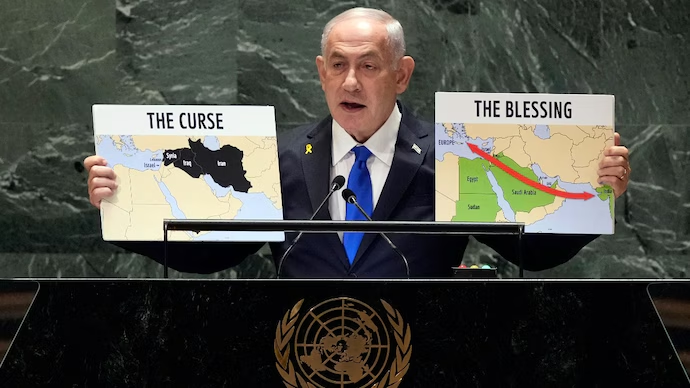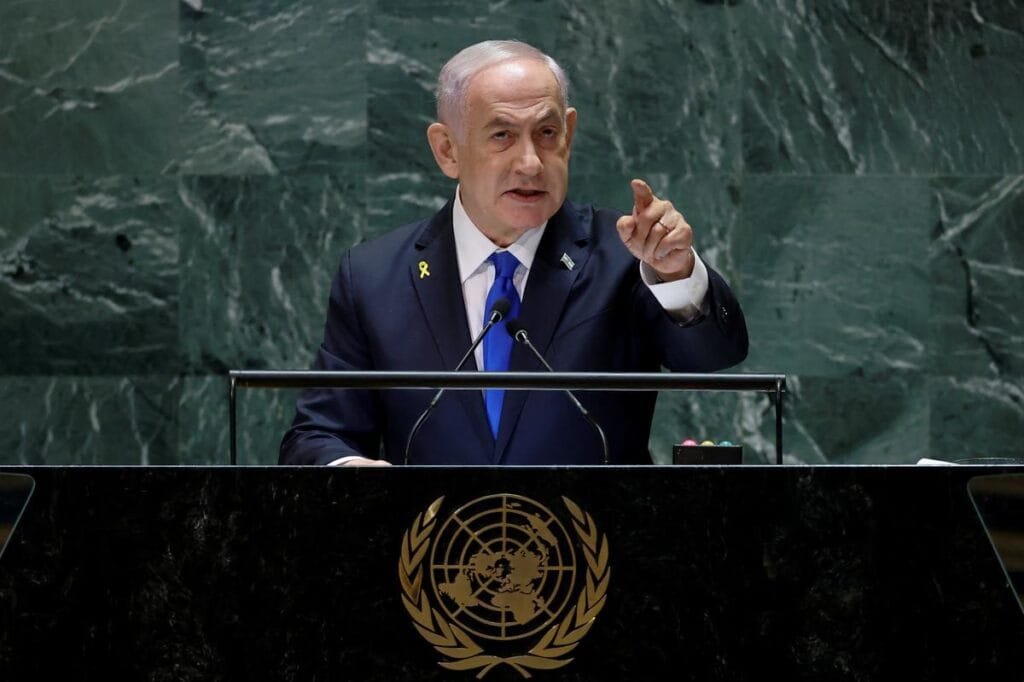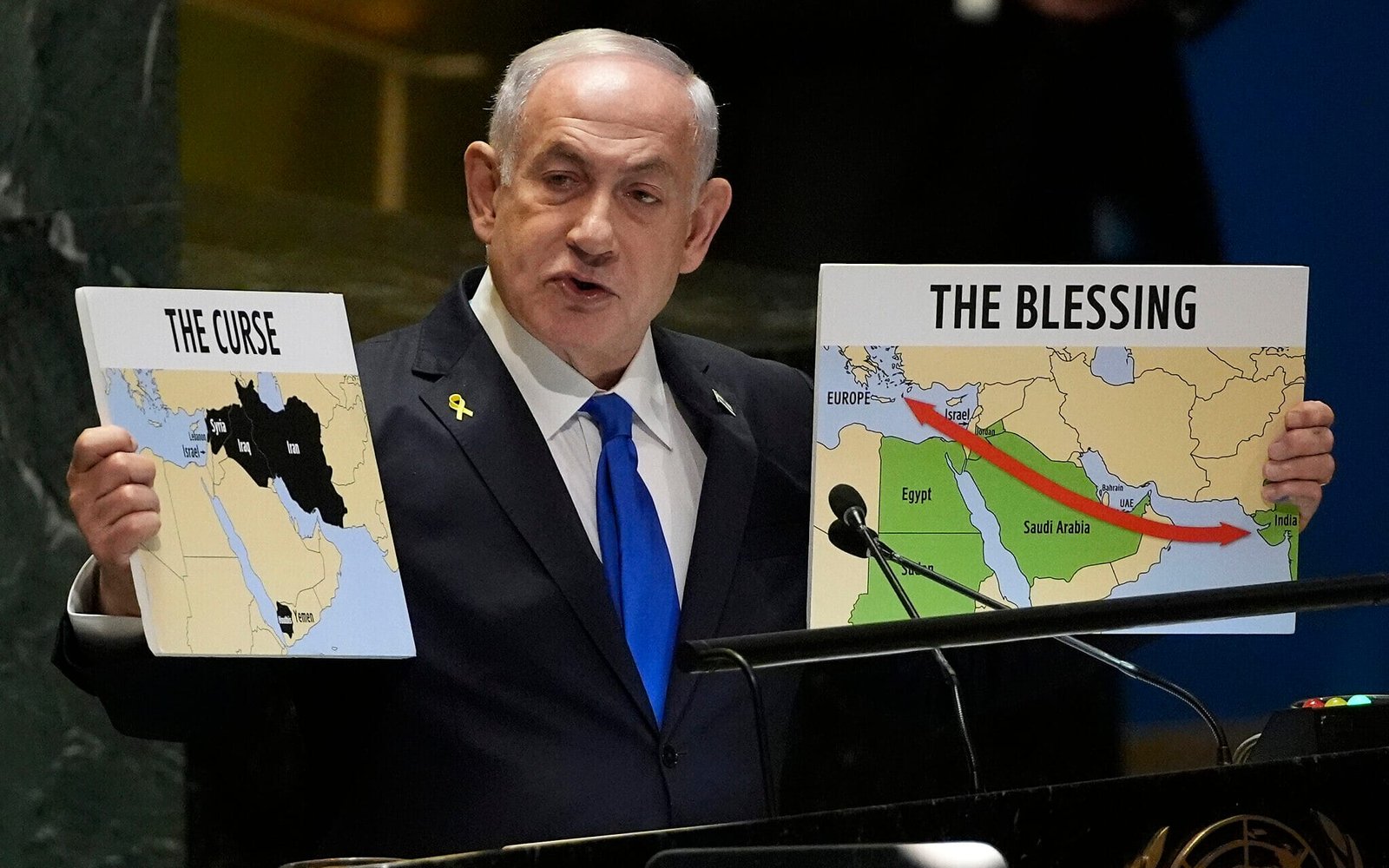| In Short |
| India as ‘The Blessing’: Benjamin Netanyahu labeled India as a key ally, showcasing strong ties between the two nations. |
| Iran as ‘The Curse’: Iran was marked as a major adversary, emphasizing the ongoing conflict and threat Israel perceives from Iran. |
| Shifting Alliances: The maps illustrated Israel’s changing regional relationships, with new allies and longstanding rivals. |
| UN Address Focus: Netanyahu’s speech centered on the contrast between nations that support or threaten Israel’s security. |
| Visual Message: The two maps served as a powerful visual representation of Israel’s strategic outlook. |
Israeli Prime Minister Benjamin Netanyahu took center stage at the United Nations General Assembly, delivering a speech that captured global attention. Netanyahu introduced two maps, depicting Israel’s allies as a “blessing” and its adversaries as a “curse.” His bold move underscored Israel’s strategic relationships and highlighted the growing tension with Iran, conveying a clear message about the Middle East’s complex geopolitical landscape.
The Two Maps: A Clear Distinction Between Allies and Adversaries
In his first speech at the UN since the recent Gaza war, Netanyahu presented two contrasting maps. The map on his right showed countries like Iran, Iraq, Syria, and Yemen painted in black, marked as “The Curse.” Meanwhile, the map on his left depicted nations like Egypt, Sudan, Saudi Arabia, and India in green, symbolizing them as “The Blessing.” Notably, both maps included the Palestinian territories of the West Bank and Gaza as part of Israel, a detail that did not go unnoticed by observers.
Netanyahu’s visual presentation was an attempt to draw attention to the shifting dynamics in the Middle East, emphasizing the growing ties between Israel and its neighboring Arab countries, while spotlighting the threat posed by Iran and its allies.
Netanyahu’s Focus on Iran: A Stern Warning
Netanyahu directed strong criticism at Iran, stating that it was the primary source of conflict in the Middle East. He warned Tehran, saying, “If you strike us, we will strike you,” and emphasized that Israel’s reach extends across the entire region. This statement underscored Israel’s readiness to confront any threat, reinforcing the country’s commitment to defending its sovereignty and interests against Iranian aggression.

Netanyahu’s comments come amid increasing tensions between Israel and Iran, which has a history of supporting regional militias like Hezbollah. This fiery rhetoric serves as a reminder of the potential for escalating conflict in the Middle East, with Israel firmly positioning itself against Iran’s influence.
India as a ‘Blessing’ on the Map
India’s inclusion on the “blessing” side of Netanyahu’s map was significant. The relationship between Israel and India has grown stronger over the years, with both nations collaborating on various fronts, including defense, technology, and trade. Indian Prime Minister Narendra Modi was one of the first world leaders to condemn attacks on Israel, further solidifying the bond between the two countries. Netanyahu’s visual depiction of India as an ally highlighted the importance of this relationship in Israel’s strategic alliances.
The Palestinian Territories and the Two-State Solution
Benjamin Netanyahu’s maps displayed the West Bank and Gaza Strip as part of Israel, sparking controversy given the ongoing Israeli-Palestinian conflict. Despite the provocative presentation, the Israeli Prime Minister reiterated that Palestinians must stop promoting anti-Semitism and recognize Israel’s right to exist. This stance aligns with Israel’s broader narrative of seeking peace while defending its sovereignty, yet it continues to be a point of contention in the pursuit of a two-state solution.

Israel’s Regional Relationships: A Shift in Dynamics
Benjamin Netanyahu’s address at the UN emphasized Israel’s evolving relationships with several Arab countries. The Abraham Accords, which facilitated normalization agreements between Israel and several Arab states, including the UAE, Bahrain, and Sudan, signaled a new era of cooperation in the region. By showcasing Egypt, Sudan, and Saudi Arabia on the “blessing” map, Netanyahu reinforced the idea that Israel’s diplomatic ties in the Middle East are strengthening, despite the longstanding conflict with Iran and its allies.
Netanyahu’s Message to the World: A Choice Between ‘Blessing’ and ‘Curse’
The central theme of Netanyahu’s speech was clear: the world must choose between supporting peace and prosperity (“blessing”) or continuing conflict and terrorism (“curse”). His message was aimed at rallying support against Iran and urging nations to recognize Israel’s role as a stabilizing force in the region. By using the two maps, Netanyahu hoped to simplify the complex geopolitical issues facing the Middle East, framing them as a choice between good and evil.

Benjamin Netanyahu’s speech at the UN was a defining moment, showcasing Israel’s stance on regional security, alliances, and the persistent threat posed by Iran. The two maps he presented were more than just visual aids; they were a powerful statement about Israel’s position in a rapidly changing Middle Eastern landscape. As tensions continue to rise, Netanyahu’s call for a choice between “blessing” and “curse” will undoubtedly shape future discourse around Israel’s role in regional and global affairs.
The world watches closely as Israel navigates these challenges, with Netanyahu’s speech serving as a bold reminder of the stakes involved in the pursuit of peace and security in the Middle East.
For Latest News Updates Click Here.
